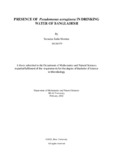Presence of Pseudomonas Aeruginosa in drinking water of Bangladesh

View/Open
Date
2022-02Publisher
Brac UniversityAuthor
Momtaz, Sumaiya SadiaMetadata
Show full item recordAbstract
Pseudomonas aeruginosa is an opportunistic pathogen and is responsible for nosocomial infections. It is notorious bacteria and can even survive in distilled water. Its presence in drinking water can be dangerous as it can be harmful as well as deadly to immunocompromised individuals. Though it does not normally harm healthy individuals, its ability to infect immunocompromised can be ignored. Furthermore, recently is it considered as a secondary indicator organism to check water quality after Fecal and Total coliforms. In contrast, it has intrinsically and extrinsically developed antibiotic resistance to several antibiotics which is a matter of concern. As Bangladesh is a densely populated country of the world, consumption of contaminated water leads to water-borne diseases. According to WHO, 97% of people have the access to water but most of the waters are not appropriate for drinking. In recent years many studies have been done in Bangladesh to access the water quality. However, most of the research has been focused on the presence of Fecal and Total coliform. In this study, 65 drinking water samples have been collected from different regions of Dhaka city and outside of Dhaka city to identify Pseudomonas aeruginosa. It has been observed that most of the samples from Dhaka city are contaminated with Pseudomonas aeruginosa compared to other locations outside Dhaka City. It has been seen that the range of the contamination is very high in Dhaka City specifically in Kafrul. Among 65 samples 40(62%) samples were culture positive and 25(38%) samples were culture negative. Among culture-positive samples, two isolates have been collected for molecular confirmation, and among culture-positive samples 66% of isolates were molecularly confirmed Pseudomonas aeruginosa. It has been found that among molecularly confirmed isolates, 100% isolates were resistant to Ampicillin, 38% isolates were resistant to Fosfomycin, 10% isolates were resistant to Azithromycin and 7% isolates were resistant to Polymyxin B. This can be an alarming issue as Drinking water should not contain any Pseudomonas aeruginosa. However, most of the isolates showed sensitivity to other antibiotics and no such isolates showed MDR which is good news indicating that the samples that have been collected do not contain a harmful strain of Pseudomonas aeruginosa in the sense that most of the strains were sensitive to antibiotics.
